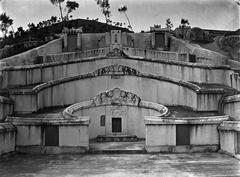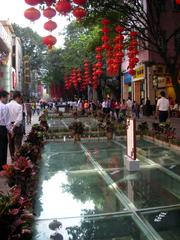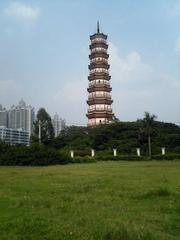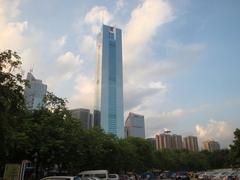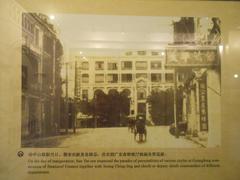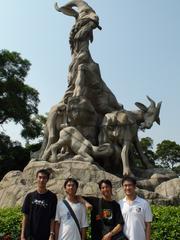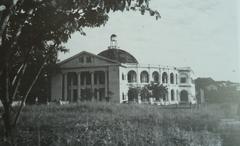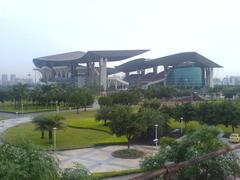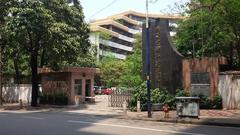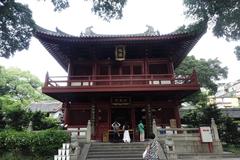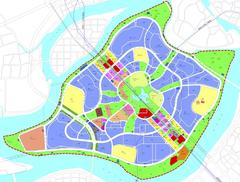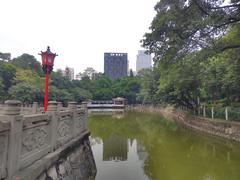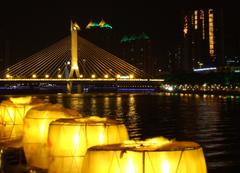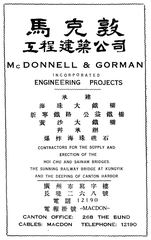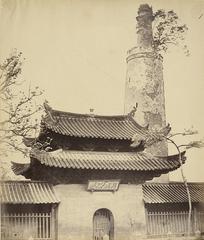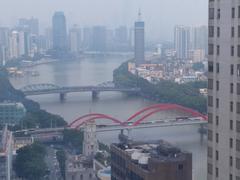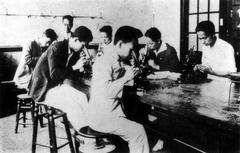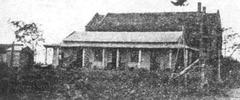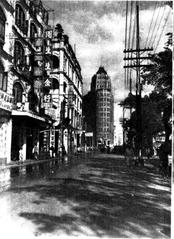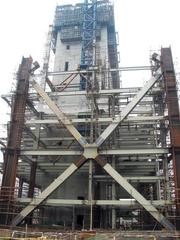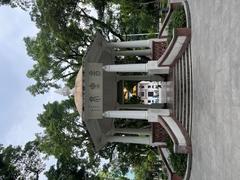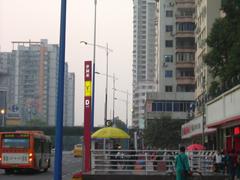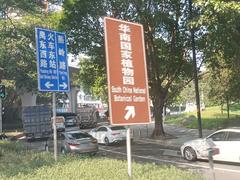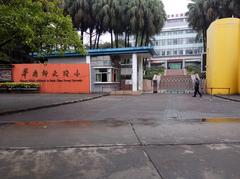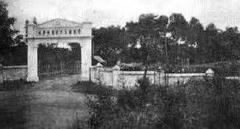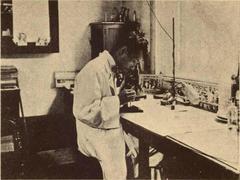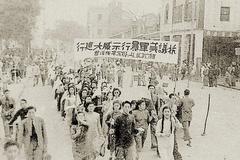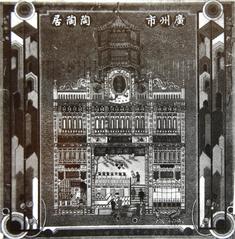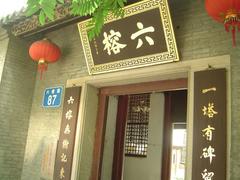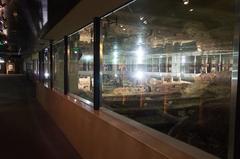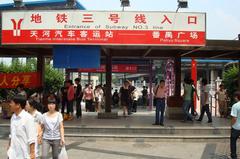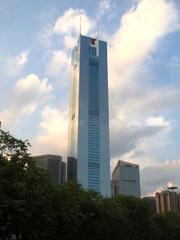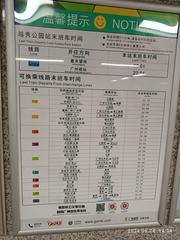
Hualin Temple Guangzhou: Visiting Hours, Tickets & Historical Sites Guide
Date: 04/07/2025
Introduction
Nestled in Guangzhou’s historic Liwan District, Hualin Temple (华林寺) is an enduring testament to the city’s Buddhist heritage and its rich legacy of cross-cultural exchange. With roots extending back to the 6th century and closely linked to the legendary Bodhidharma—the Indian monk credited with founding Chan (Zen) Buddhism in China—Hualin Temple offers more than just spiritual sanctuary. It is a living chronicle of over a millennium of religious, artistic, and architectural evolution, and a vital stop for anyone seeking to understand Guangzhou’s place along the ancient Maritime Silk Road (Wikipedia; Guangzhou Government; irkhome.com).
This comprehensive guide provides essential information about visiting hours, ticketing, historical and architectural highlights, nearby attractions, accessibility, and practical travel tips—ensuring a rewarding visit to this treasured Guangzhou landmark.
Table of Contents
- Origins and Foundation
- Historical Evolution
- Bodhidharma & the Spread of Chan Buddhism
- Role in Indian Buddhism Transmission
- Architectural Features
- Cultural Heritage & Artistic Value
- Religious Significance & Community Role
- Visiting Information (Hours, Tickets, Accessibility)
- Travel Tips & Nearby Attractions
- Special Events & Guided Tours
- FAQ
- Summary & Conclusion
- References
Origins and Foundation
Hualin Temple’s origins date to the early 6th century CE, during the Liang Dynasty, when the region became a vibrant center for Buddhist learning and exchange. Originally established as Xilai Monastery (Xilaiyan), the temple’s founding is intimately tied to Bodhidharma, who, according to tradition, arrived in Guangzhou via the Pearl River and established the site as a hub for Buddhist worship and meditation. This “Landing Ground of Dharma” symbolizes the transmission of Buddhist teachings from India to southern China, reflecting Guangzhou’s strategic role along the Maritime Silk Road (irkhome.com; Guangzhou Government).
Historical Evolution
Through successive dynasties, Hualin Temple underwent cycles of destruction, restoration, and transformation. It flourished as a Buddhist center during the Tang, Song, and Yuan dynasties, serving as a repository for sacred relics and scriptures brought from India and Central Asia. The Ming and Qing eras saw further renovations and expansions, with the temple weathering political upheavals and anti-Buddhist campaigns. Despite the devastation of the Cultural Revolution, when the site was repurposed as a natural history museum (Sukha Sights Blog), restoration efforts in recent decades have revived Hualin Temple as an active religious and cultural site (Wikipedia).
Bodhidharma and the Spread of Chan Buddhism
One of Hualin Temple’s most enduring legends is its association with Bodhidharma, the founder of Chan (Zen) Buddhism in China. While historical records of his direct presence remain debated, the temple commemorates him with a dedicated hall and statue, and serves as a pilgrimage site for Zen practitioners. His arrival symbolizes Guangzhou’s role as a bridge between Indian and Chinese Buddhist traditions (irkhome.com; Guangzhou Insider).
Role in Indian Buddhism Transmission
Hualin Temple, together with Guangxiao and Liurong Temples, was pivotal in transmitting Indian Buddhist scriptures, relics, and philosophies into China. The temple housed many translated texts and trained monks who played key roles in the dissemination of Buddhism throughout East Asia (irkhome.com).
Architectural Features
Hualin Temple exemplifies traditional Lingnan (southern Chinese) architecture, with a classic north-south axis layout leading visitors through successive courtyards and halls. Notable features include:
- Main Hall (Daxiong Baodian): Showcases timber-frame construction, ornate dougong (brackets), and Sakyamuni Buddha statues.
- Five-Hundred-Arhat Hall (五百罗汉堂): Home to 500 unique, life-sized Arhat statues, each with distinctive expressions and poses. This hall replaces the traditional Grand Hall and is a highlight for art lovers.
- Dharma Hall: Dedicated to Bodhidharma, with murals depicting his journey and spiritual legacy (Guangzhou Government).
- Zen Courtyards: Shaded by ancient banyan trees and featuring lotus ponds, the courtyards provide tranquil spaces for reflection.
- Decorative Elements: Roof ridges adorned with ceramic dragons and phoenixes, intricate woodcarvings, and vibrant Lingnan color schemes.
While the original Gilded Ashoka Pagoda and Arhat statues were lost during the Cultural Revolution, significant restorations and new sculptures, including a towering Bodhidharma statue, have revived the temple’s artistic vibrancy (Wikipedia; GZ Guide).
Cultural Heritage and Artistic Value
Hualin Temple’s art and relics, including murals, sculptures, and ritual objects, showcase centuries of craftsmanship and devotion. The temple’s legacy as a center for Buddhist art is evident in its unique Arhat statues, which draw visitors for both spiritual and aesthetic appreciation (eTourBook).
Religious Significance and Community Role
As one of Guangzhou’s “Four Great Buddhist Temples,” Hualin plays a vital role in the city’s religious life. It is a hub for worship, meditation, and community events, hosting major Buddhist festivals, regular ceremonies, and meditation retreats (PMS Stoper). Its ongoing restoration and community outreach reflect the resilience and relevance of Buddhist traditions in modern Guangzhou.
Visiting Information: Hours, Tickets, Accessibility
Opening Hours
Ticket Prices
- Entry: Free of charge (no tickets required)
(Foreignercn.com)
Location & Transport
- Address: No. 31 Hualinsi Front Street, Liwan District, Guangzhou
- Metro: Line 1 (Changshou Lu Station) or Line 6 (Ximenkou Station); both within walking distance
- Bus: Lines 79, 82, 6, 61, 3, 530, 2, 823, 556
Accessibility
- The temple has ramps and mostly flat paths, but some halls have steps and uneven surfaces. Wheelchair access is limited; advance inquiry is advised.
Facilities
- Restrooms, shaded courtyards, water dispensers. No extensive dining facilities on-site, but numerous eateries are nearby.
Travel Tips and Nearby Attractions
- Dress Modestly: Shoulders and knees should be covered; hats off inside halls.
- Photography: Allowed in most areas, but avoid flash and respect signs in prayer halls.
- Best Time to Visit: Weekday mornings for tranquility; Buddhist festivals for vibrant ceremonies.
- Nearby Attractions:
- Shangxiajiu Pedestrian Street (shopping, street food)
- Chen Clan Ancestral Hall (Lingnan architecture)
- Guangxiao Temple and Liurong Temple (further Buddhist heritage sites)
- Canton Tower and Chimelong Parks (modern attractions)
Special Events and Guided Tours
- Festivals: Vesak, Buddha’s Birthday, and Ullambana are celebrated with special rituals and vegetarian feasts.
- Guided Tours: Local tour operators occasionally offer guided tours and meditation workshops. Check with the temple or reputable agencies for bookings.
- Workshops: Some sessions focus on meditation, calligraphy, or Buddhist art—availability varies by season.
FAQ
Q: What are Hualin Temple’s visiting hours?
A: Daily from 8:00 AM to 5:00 PM.
Q: Is there an admission fee?
A: No, admission is free.
Q: Are guided tours available?
A: Periodically, through local operators or by prior arrangement.
Q: Is the temple accessible for people with disabilities?
A: Partial access; some steps and uneven ground. Contact ahead for details.
Q: Can I take photographs?
A: Yes, in most areas except during rituals or where indicated.
Q: What are nearby attractions?
A: Shangxiajiu Pedestrian Street, Chen Clan Ancestral Hall, Guangxiao Temple, Liurong Temple, Canton Tower.
Summary and Conclusion
Hualin Temple is a living embodiment of Guangzhou’s deep Buddhist roots and its dynamic history as a crossroads of civilizations. From its 6th-century origins and legendary Bodhidharma connection to its survival through dynastic transitions and the Cultural Revolution, the temple is both a spiritual haven and a window into the city’s multicultural evolution (irkhome.com; Sukha Sights Blog).
Today, visitors can explore its tranquil courtyards, admire the unique Five-Hundred-Arhat Hall, and immerse themselves in ongoing Buddhist practice. With free entry, central location, and proximity to other cultural highlights, Hualin Temple is a must-see for pilgrims, history lovers, and travelers alike.
For real-time updates, guided tour bookings, and more travel inspiration, download the Audiala app and follow our social media channels. Plan your journey to Hualin Temple and experience the enduring spirit of Guangzhou’s spiritual and cultural heritage.
References
- Hualin Temple (Guangzhou) – Wikipedia
- Temples in Guangzhou and Their Connection to Indian Buddhism – irkhome.com
- Hualin Temple - Guangzhou Travel Information – GZ Guide
- Hualin Temple Visiting Hours and Information – Trip.com
- Stories of Buddhist Old Zen Temples – Sukha Sights Blog
- Hualin Temple Historical Overview – Guangzhou Government
- Foreignercn.com: Hualin Temple
- Guangzhou Insider: Hualinsi Historical Neighbourhood
- eTourBook: Hualin Temple
- PMS Stoper – The Importance of Buddhism in Guangzhou’s Tourism






























